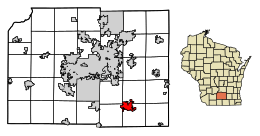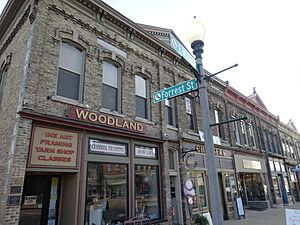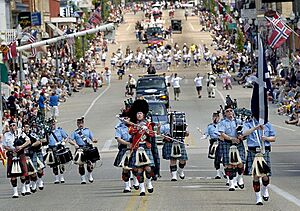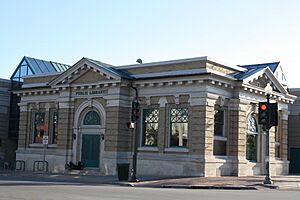Stoughton, Wisconsin facts for kids
Quick facts for kids
Stoughton, Wisconsin
|
|
|---|---|

|
|

Location of Stoughton in Dane County, Wisconsin
|
|
| Country | |
| State | |
| County | Dane |
| Area | |
| • Total | 6.35 sq mi (16.45 km2) |
| • Land | 6.02 sq mi (15.58 km2) |
| • Water | 0.33 sq mi (0.86 km2) |
| Elevation | 876 ft (267 m) |
| Population
(2020)
|
|
| • Total | 13,173 |
| • Estimate
(2021)
|
13,085 |
| • Density | 2,179.49/sq mi (841.54/km2) |
| Time zone | UTC-6 (Central (CST)) |
| • Summer (DST) | UTC-5 (CDT) |
| ZIP Code |
53589
|
| Area code(s) | 608 |
| FIPS code | 55-77675 |
| GNIS feature ID | 1574965 |
Stoughton is a city in Dane County, Wisconsin, United States. It straddles the Yahara River about 20 miles (32 km) southeast of the state capital, Madison. As of the 2020 census, the population was 13,173. Stoughton is part of the Madison metropolitan area.
Known for its Norwegian heritage, Stoughton hosts a citywide celebration of Syttende Mai, the Norwegian constitution day. Part of the city's celebration of its Norwegian heritage is the Stoughton Norwegian Dancers dance group, sponsored by Stoughton High School, as well as Norwegian flags and memorabilia displayed throughout the town.
Contents
History
Stoughton was founded in 1847 by Luke Stoughton, an Englishman from Vermont. Many Norwegian immigrants settled in the town from 1865 through the early 1900s.
Stoughton claims to be the birthplace of the "coffee break", and hosts a small yearly parade to celebrate the distinction.
For much of its history, Stoughton has been Dane County's second-largest and economically important city, after Madison.
In 1919, the Stoughton Wagon Company began putting custom wagon bodies on Model T chassis; by 1929 Ford was by far the biggest seller of station wagons.
On August 18, 2005, an F3 tornado cut a 10-mile path across rural subdivisions and farms north of Stoughton, killing one person and damaging hundreds of homes.
Geography
According to the United States Census Bureau, the city has a total area of 5.09 square miles (13.18 km2), of which, 4.92 square miles (12.74 km2) is land and 0.17 square miles (0.44 km2) is water.
Climate
| Climate data for Stoughton Wastewater Treatment Plant, Wisconsin (1991–2020 normals, extremes 1949–present) | |||||||||||||
|---|---|---|---|---|---|---|---|---|---|---|---|---|---|
| Month | Jan | Feb | Mar | Apr | May | Jun | Jul | Aug | Sep | Oct | Nov | Dec | Year |
| Record high °F (°C) | 56 (13) |
70 (21) |
82 (28) |
92 (33) |
96 (36) |
101 (38) |
103 (39) |
103 (39) |
98 (37) |
89 (32) |
77 (25) |
66 (19) |
103 (39) |
| Mean daily maximum °F (°C) | 27.2 (−2.7) |
31.4 (−0.3) |
43.5 (6.4) |
57.2 (14.0) |
69.4 (20.8) |
79.3 (26.3) |
82.9 (28.3) |
81.0 (27.2) |
74.2 (23.4) |
60.8 (16.0) |
45.6 (7.6) |
32.6 (0.3) |
57.1 (13.9) |
| Daily mean °F (°C) | 18.5 (−7.5) |
22.0 (−5.6) |
33.5 (0.8) |
45.8 (7.7) |
57.7 (14.3) |
68.0 (20.0) |
71.9 (22.2) |
69.8 (21.0) |
62.1 (16.7) |
49.7 (9.8) |
36.2 (2.3) |
24.4 (−4.2) |
46.6 (8.1) |
| Mean daily minimum °F (°C) | 9.7 (−12.4) |
12.5 (−10.8) |
23.4 (−4.8) |
34.4 (1.3) |
46.0 (7.8) |
56.8 (13.8) |
60.9 (16.1) |
58.7 (14.8) |
50.0 (10.0) |
38.6 (3.7) |
26.8 (−2.9) |
16.2 (−8.8) |
36.2 (2.3) |
| Record low °F (°C) | −35 (−37) |
−33 (−36) |
−16 (−27) |
2 (−17) |
22 (−6) |
34 (1) |
41 (5) |
38 (3) |
19 (−7) |
12 (−11) |
−12 (−24) |
−29 (−34) |
−35 (−37) |
| Average precipitation inches (mm) | 1.62 (41) |
1.68 (43) |
2.20 (56) |
3.94 (100) |
4.28 (109) |
5.22 (133) |
3.79 (96) |
4.26 (108) |
3.54 (90) |
2.98 (76) |
2.51 (64) |
1.77 (45) |
37.79 (960) |
| Average snowfall inches (cm) | 10.4 (26) |
10.6 (27) |
4.5 (11) |
0.7 (1.8) |
0.0 (0.0) |
0.0 (0.0) |
0.0 (0.0) |
0.0 (0.0) |
0.0 (0.0) |
0.4 (1.0) |
1.3 (3.3) |
7.6 (19) |
35.5 (90) |
| Average precipitation days (≥ 0.01 in) | 7.4 | 7.2 | 7.7 | 10.5 | 11.8 | 11.0 | 8.5 | 9.0 | 8.3 | 8.6 | 7.7 | 7.9 | 105.6 |
| Average snowy days (≥ 0.1 in) | 5.1 | 4.7 | 1.9 | 0.4 | 0.0 | 0.0 | 0.0 | 0.0 | 0.0 | 0.2 | 1.1 | 4.5 | 17.9 |
| Source: NOAA | |||||||||||||
Demographics
| Historical population | |||
|---|---|---|---|
| Census | Pop. | %± | |
| 1850 | 70 | — | |
| 1870 | 985 | — | |
| 1880 | 1,353 | 37.4% | |
| 1890 | 2,470 | 82.6% | |
| 1900 | 3,431 | 38.9% | |
| 1910 | 4,761 | 38.8% | |
| 1920 | 5,101 | 7.1% | |
| 1930 | 4,497 | −11.8% | |
| 1940 | 4,743 | 5.5% | |
| 1950 | 4,833 | 1.9% | |
| 1960 | 5,555 | 14.9% | |
| 1970 | 6,096 | 9.7% | |
| 1980 | 7,589 | 24.5% | |
| 1990 | 8,786 | 15.8% | |
| 2000 | 12,354 | 40.6% | |
| 2010 | 12,611 | 2.1% | |
| 2020 | 13,173 | 4.5% | |
| U.S. Decennial Census | |||
2020 census
As of the census of 2020 there were 13,173 people, 5,262 households, and 3,296 families residing in the city. The racial makeup of the city was 96.6% White, 0.9% African American, 0.1% Native American, 0.0% Asian, and 1.7% from two or more races. Hispanic or Latino people of any race were 1.9% of the population.
The age and gender makeup of the city was 6.8% under the age of 5, 26.5% under 18, 17.5% over the age of 65 and 52.0% female. Of the total population, 601 were veterans.
2010 census
As of the census of 2010, there were 12,611 people, 5,133 households, and 3,296 families residing in the city. The population density was 2,563.2 inhabitants per square mile (989.7/km2). There were 5,419 housing units at an average density of 1,101.4 per square mile (425.3/km2). The racial makeup of the city was 95.1% White, 1.4% African American, 0.2% Native American, 1.3% Asian, 0.4% from other races, and 1.5% from two or more races. Hispanic or Latino people of any race were 1.8% of the population.
There were 5,133 households, of which 33.6% had children under the age of 18 living with them, 49.3% were married couples living together, 10.7% had a female householder with no husband present, 4.2% had a male householder with no wife present, and 35.8% were non-families. 29.4% of all households were made up of individuals, and 12.4% had someone living alone who was 65 years of age or older. The average household size was 2.41 and the average family size was 2.99.
The median age in the city was 39.2 years. 25.1% of residents were under the age of 18; 6.5% were between the ages of 18 and 24; 27.6% were from 25 to 44; 26.2% were from 45 to 64; and 14.6% were 65 years of age or older. The gender makeup of the city was 47.2% male and 52.8% female.
Economy
The corporate headquarters and semi-trailer manufacturing facility for Stoughton Trailers are located in Stoughton, where the company has been locally owned and operated for more than 50 years. The 680,000 sq. ft. Stoughton plant houses everything from fabrication of subassemblies to final assembly of all Stoughton dry vans. Stoughton Trailers is one of the largest truck trailer manufacturing companies in North America, and is the only American company still manufacturing 53-foot-long "intermodal" freight containers used to ship goods internationally.
Another large employer in the city is Uniroyal Engineered Products, makers of Naugahyde. Stoughton and its environs are also home to printers, and manufacturers of foodstuffs, chemicals, and sundry other products. North American Fur Auctions' US offices are based in Stoughton.
Stoughton Utilities, a municipally-owned utility, provides electrical, water and sewer service to the city.
Arts and culture
The coffee break is said to have originated in Stoughton, when immigrant men became employed en masse at T. G. Mandt's wagon factory, leaving their wives to fill the shortages at the tobacco warehouses. They agreed to work under the condition that they were allowed to go home every morning and afternoon to tend to chores and, of course, drink coffee. The city of Stoughton celebrates the coffee break every summer with the Stoughton Coffee Break Festival.
The first weekend in December marks Stoughton's Victorian Holiday Weekend, celebrating the city's Victorian homes and commercial buildings. Events include a Victorian Holiday Ball with period dances, a production of the Nutcracker Ballet or A Christmas Carol (alternates each year), carriage rides, a silent decorated fire truck parade, a children's parade.
The weekend closest to May 17, Norwegian Constitution Day, marks Stoughton's Syttende Mai festival. The celebration includes parades, an art fair, Norwegian dance performances, races, and other events. The Stoughton Chamber of Commerce has planned the festival every year since 1967.
In 2004, a Norwegian TV crew traveled to the Midwest to witness modern manifestations of Norsky culture in the US. They visited Stoughton, Mount Horeb and Decorah, Iowa. Their documentary Ja, de elsker (Yes, they love, a reference to the Norwegian national anthem) was aired on NRK1 on May 16 and 17, 2006.
Education
Stoughton is served by the Stoughton Area School District, which covers most of southeastern Dane County as well as a small portion of Rock County. SASD operates three elementary schools, one middle school, and one high school. There is no higher education in the city, but a UW science lab operates in rural Stoughton on Schneider Road.
Media
The weekly Stoughton Courier-Hub newspaper, founded in 1969, is published on Thursdays.
WSTO TV is a public, educational, and government access (PEG) cable TV channel operated by The City of Stoughton's Information Technology/Media Services Department.
The 495-seat Stoughton Opera House features about 30 traveling musical, comedy and other acts each year.
Transportation
Stoughton is served by Interstate 39 (I-39) and I-90, which run concurrently and have two exits five miles (8.0 km) north (Exit 147) and west (Exit 156) of the city. US Highway 51 comes from Madison and goes along the west side of town, then turns east through downtown towards the Interstates. US Highway 14 has an exit for Stoughton at Wisconsin Highway 138 6 miles west of the city in the village of Oregon. WIS-138 heads west at US-14 from Oregon into Stoughton, then goes south towards the unincorporated Cooksville.
A small general aviation airport is located two miles (3.2 km) east of the city. Commercial air service is provided by Dane County Regional Airport.
Notable people
- Ole Amundsen Buslett, author
- John Edward Erickson, Governor of Montana, born in Stoughton
- Jerry Frei, head coach of the Oregon Ducks football team, NFL assistant coach
- Gale Gillingham, Green Bay Packer Hall of Fame
- Russell Hellickson, silver medalist in freestyle wrestling at the 1976 Summer Olympics
- Bob Homme, star of the Canadian television series The Friendly Giant
- Henry Huber, Lieutenant Governor of Wisconsin
- Justin Jacobs, 2014 PECASE winner, Orlando Magic statistician
- Ole C. Lee, Wisconsin State Representative
- Thomas A. Loftus, United States ambassador to Norway, Wisconsin politician
- Louis K. Luse, Wisconsin State Representative and lawyer
- Per Lysne, artist
- Alonzo J. Mathison, Wisconsin State Representative
- John McCarthy, Nebraska politician and member of the United States House of Representatives, born in Stoughton
- John E. McCoy, U.S. Air National Guard general
- Henry Everett McNeil, writer
- William P. Murphy, Nobel Prize laureate
- Truman O. Olson, Medal of Honor recipient
- Andrew Rein, silver medal in freestyle wrestling (lightweight class) at the 1984 Summer Olympics
- Ole K. Roe, Wisconsin State Representative
- Christopher J. Rollis, Wisconsin State Representative and newspaper editor
- Rudy Silbaugh, Wisconsin State Representative
- Carl W. Thompson, Wisconsin State Senator
- Charles D. Wells, Wisconsin State Representative
- Norman Wengert, political scientist
- Wayne W. Wood, Wisconsin State Representative
- Ralph Wise Zwicker, U.S. Army Major General
See also
 In Spanish: Stoughton (Wisconsin) para niños
In Spanish: Stoughton (Wisconsin) para niños






